In the world of digital marketing where precision and speed are key to driving results, businesses are increasingly turning to AI-driven ads to help them keep pace with their competitors.

As one of the most powerful advertising platforms, Google Ads allows businesses to reach highly targeted audiences, but the success of a Google Ads campaign often boils down to the quality of the ad copy. Writing compelling Google Ads that attract clicks and convert those clicks into customers is a skill that takes time and practice.
Enter AI, specifically ChatGPT. As an advanced language model, ChatGPT can assist in generating, refining, and optimizing Google Ads copy, making it easier to write ads that resonate with your target audience than ever before. AI can help automate the ad creation process, improve the quality of your Google Ads copy, and facilitate robust split testing to ensure you’re maximizing the performance (and click-through rate) of your Google Ads campaigns.
So, how can you leverage ChatGPT to write high-performing search ads? In this blog post, we’ll share:
How to effectively use ChatGPT to write high-performing search ads
The best way to structure your ChatGPT prompts (with prompts you can use)
Why you need to incorporate AI into your advertising strategy if you want to keep pace with the competition
Prefer video? Check out our video on how to Upgrade Your Google Ads with AI: How to Write Winning Google Search Ads with ChatGPT on YouTube:
Still with us? Good. Let’s dive in.
Why AI is a Game Changer for Google Search Ads
Before we dive into the specifics of how to use ChatGPT to create responsive search ads, it’s important to understand why AI can drastically improve the way you run Google Ads campaigns.
Efficiency and Speed: Writing Google Ads manually can be time-consuming, especially when you’re trying to generate multiple variations for testing. AI streamlines this process, allowing you to create multiple versions of ad copy quickly (and with minimal effort).
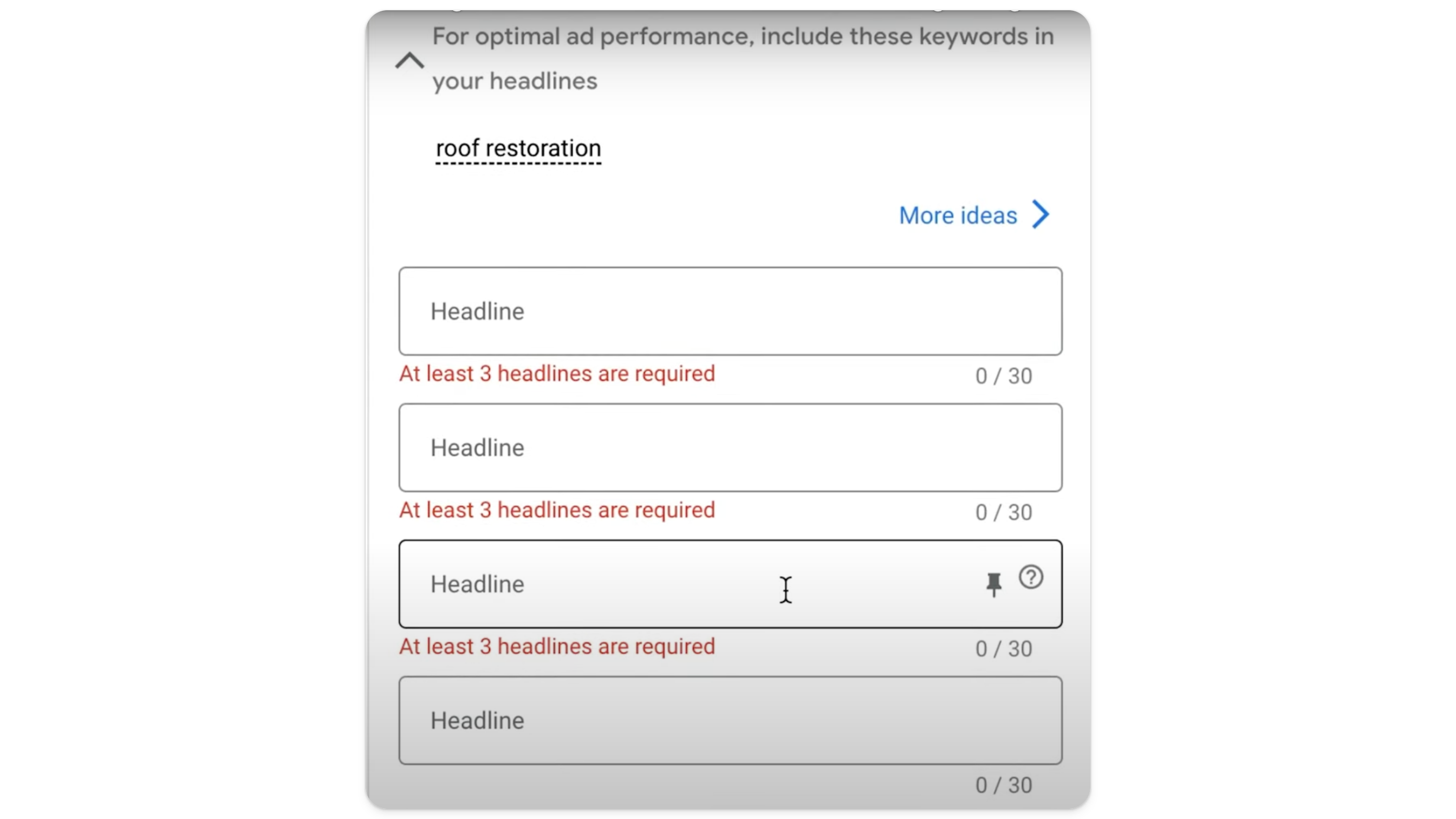
Improved Ad Quality: ChatGPT can analyze data and trends to craft ad copy that’s more likely to resonate with your target audience. AI can help you refine your messaging so that it speaks directly to the pain points, desires, and needs of your potential customers.
Optimization Opportunities: With AI, you can experiment with ad variations faster and more effectively. This enables more precise testing and a quicker path to optimizing your campaigns for better click-through rates (CTRs) and conversion rates (CVRs).
Consistency Across Campaigns: When you’re running multiple campaigns, keeping your message consistent while still fresh can be tricky. AI tools help you maintain consistency in your tone and messaging (while giving you a range of variations to use).
Now that we know why AI is important, let’s look at the specifics of using ChatGPT to write ad copy that wins clicks and conversions in Google Ads.
Step 1: Understanding Google Ads Responsive Search Ads (RSAs)
Responsive search ads (RSAs) have become a standard in Google Ads. Unlike the older expanded text ads, responsive search ads allow advertisers to input multiple headlines and descriptions. Google’s machine learning will then automatically test different combinations of headlines and descriptions to determine which perform best in various search contexts.
Here’s how responsive search ads are structured:
Headlines: Google asks you to create headlines (between 3 to 15). Each headline is limited to 30 characters.
Descriptions: You can provide up to four descriptions for Google to mix and match, each with a maximum of 90 characters.
The challenge with responsive search ads is not only coming up with enough high-quality headlines and descriptions, but also ensuring they align with the goals of your ad campaign. Since Google dynamically assembles these ads, the more relevant and varied your inputs, the more likely Google will show a winning combination.

This is where ChatGPT becomes indispensable.
Step 2: Enter ChatGPT
To get started, you’ll want to frame your AI prompt in a way that leads to high-quality responsive search ad copy. This process involves giving ChatGPT clear instructions on the tone, focus, and style of your responsive search ads. By defining the context upfront, you ensure that the AI produces ad copy that closely aligns with your goals.
Here’s a simple example of a starting prompt you can use with ChatGPT:
“You are an expert direct-response copywriter who ca write high converting and high click-through rate ads for Google Ads.
You are writing Google Ads responsive search ads for the following company
[WEBSITE OF COMPANY]
[NAME OF COMPANY]
[MAIN SERVICE OFFERINGS]
[DESCRIBE YOUR IDEAL CUSTOMER]
Write 10 headlines and 5 descriptions for a Google Ads campaign for this company. Keep the headlines relevant to the main service of this company. Do not include the name of the company in headlines or descriptions. Focus on benefits.
Headlines must be no more than 30 characters in length. Write them as bullet points, not full sentences (no sentence grammar).
Descriptions must be no more than 90 characters in length.”
This prompt serves as a basic foundation, and ChatGPT will quickly generate relevant ad copy that you can consider using in your responsive search ads. You’ll notice it starts by setting the directive at the beginning, by telling the AI to act as an expert copywriter. Although this prompt is a great starting point, you may find that you need to refine the prompt further, based on the specific needs of your campaign.
Method 1: Basic Ad Generation with ChatGPT
Using the above prompt, you can quickly generate several variations of headlines and descriptions.
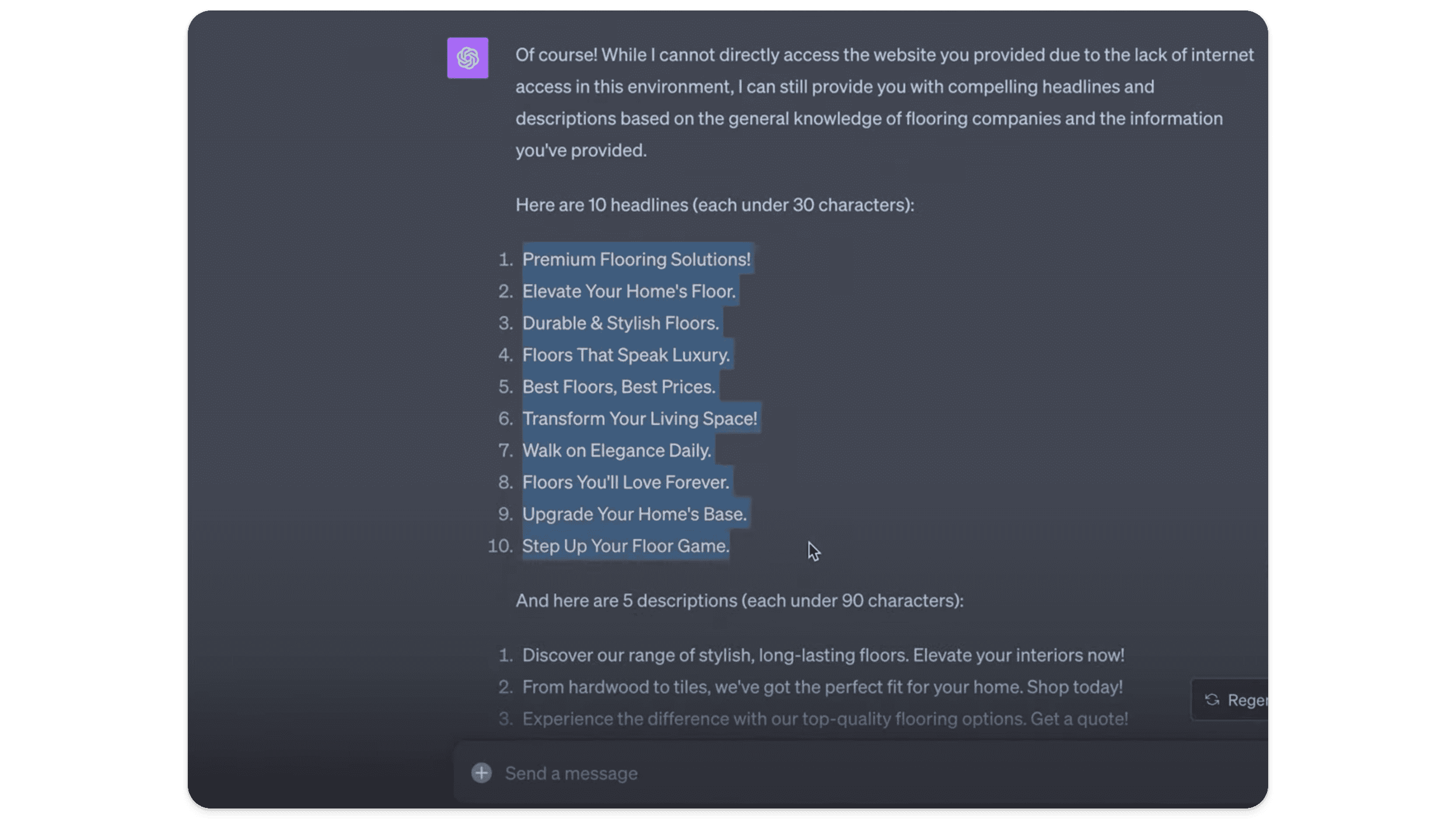
This is an excellent way to kick off the ad creation process, especially when you’re brainstorming ideas or need a quick start on a new campaign.
Pros:
Quick and easy to implement.
Allows you to generate ideas for multiple responsive search ads in a short time.
Cons:
Headlines and descriptions can lack depth or relevance to specific audience motivations.
May require additional tweaks and ad copy testing to get it just right.
While this method is great for initial ad generation, many businesses will want more tailored results. For more effective search ads, consider a more advanced method that uses your website content or competitor data to create highly specific ads geared towards your target audience.
Method 2: Website-Driven Ad Generation
To make your responsive search ads more relevant and better targeted for your Google Ads account, you can combine ChatGPT with your website content to inform your ad copy. By pulling insights directly from your website (or a competitor’s site), AI can help you generate responsive search ads that are laser-focused on the needs of your potential customers.
Here’s how you can do it:
Use Bing’s Chat Feature for Website Analysis: Since ChatGPT no longer has browsing capabilities, you can use Bing’s chat feature to analyze your website instead. Go to Bing.com/search and click on ‘Chat’ to analyze your website for key services, target market insights, and unique selling points (USPs). Here is a prompt you might use:
“Browse this website: [WEBSITE URL]
Provide the following to assist with creating marketing materials for this company:
Main list of services
Target market
Unique selling propositions
Advantages of working with this company over competitors
Main motivations of potential customers needing this service (why they need it)
Primary features of the main services
Major corresponding benefits of these services
Any other key information about this business”
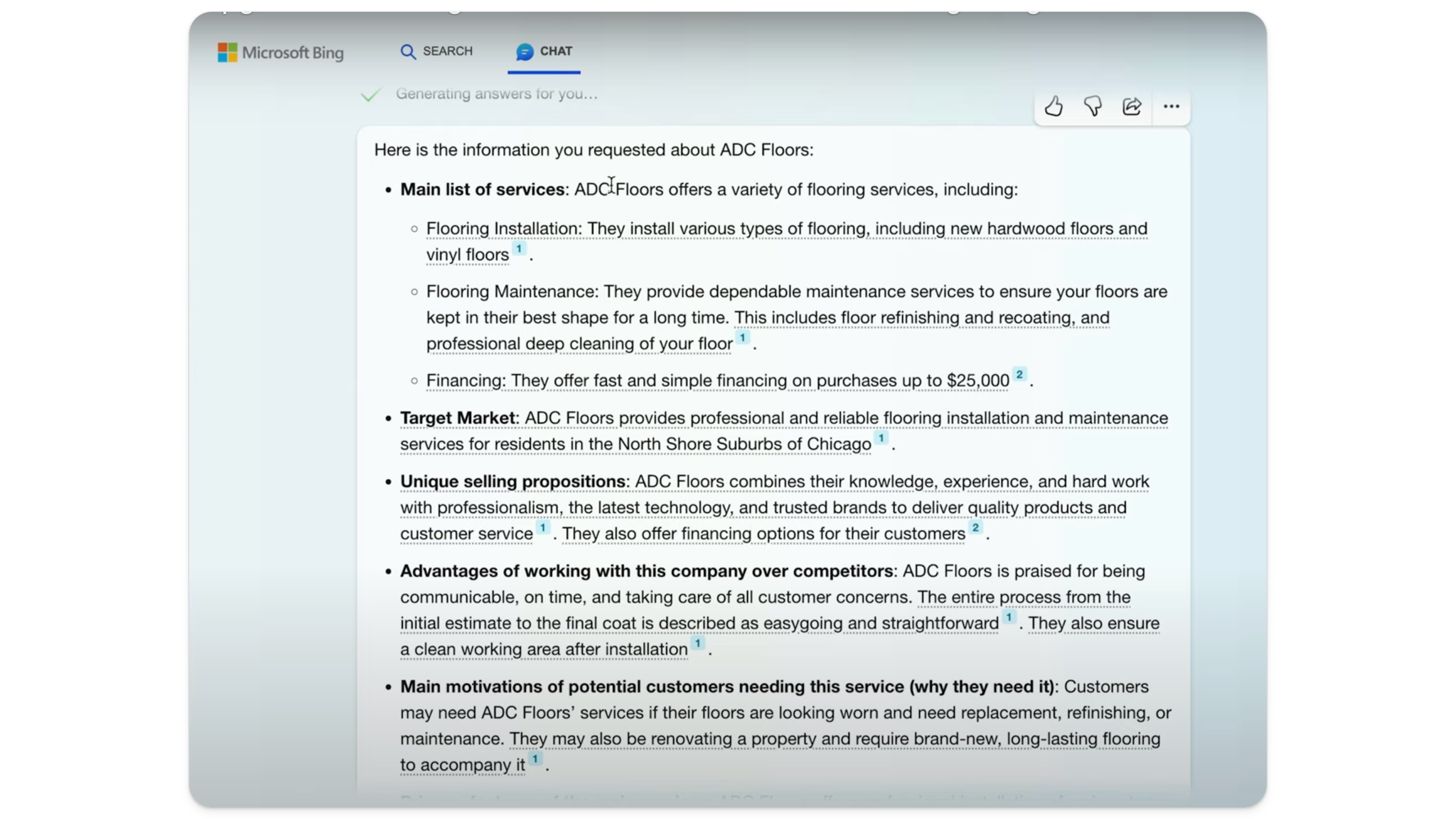
This has essentially extracted the core information we need about the business to create the most promising ad combinations.
Feed Website Data into ChatGPT: Once Bing provides a summary of your website (or a competitor’s site) using the prompt above, you can feed that information into ChatGPT with a refined prompt. Be sure to select the ‘Advanced Data Analysis’ setting.
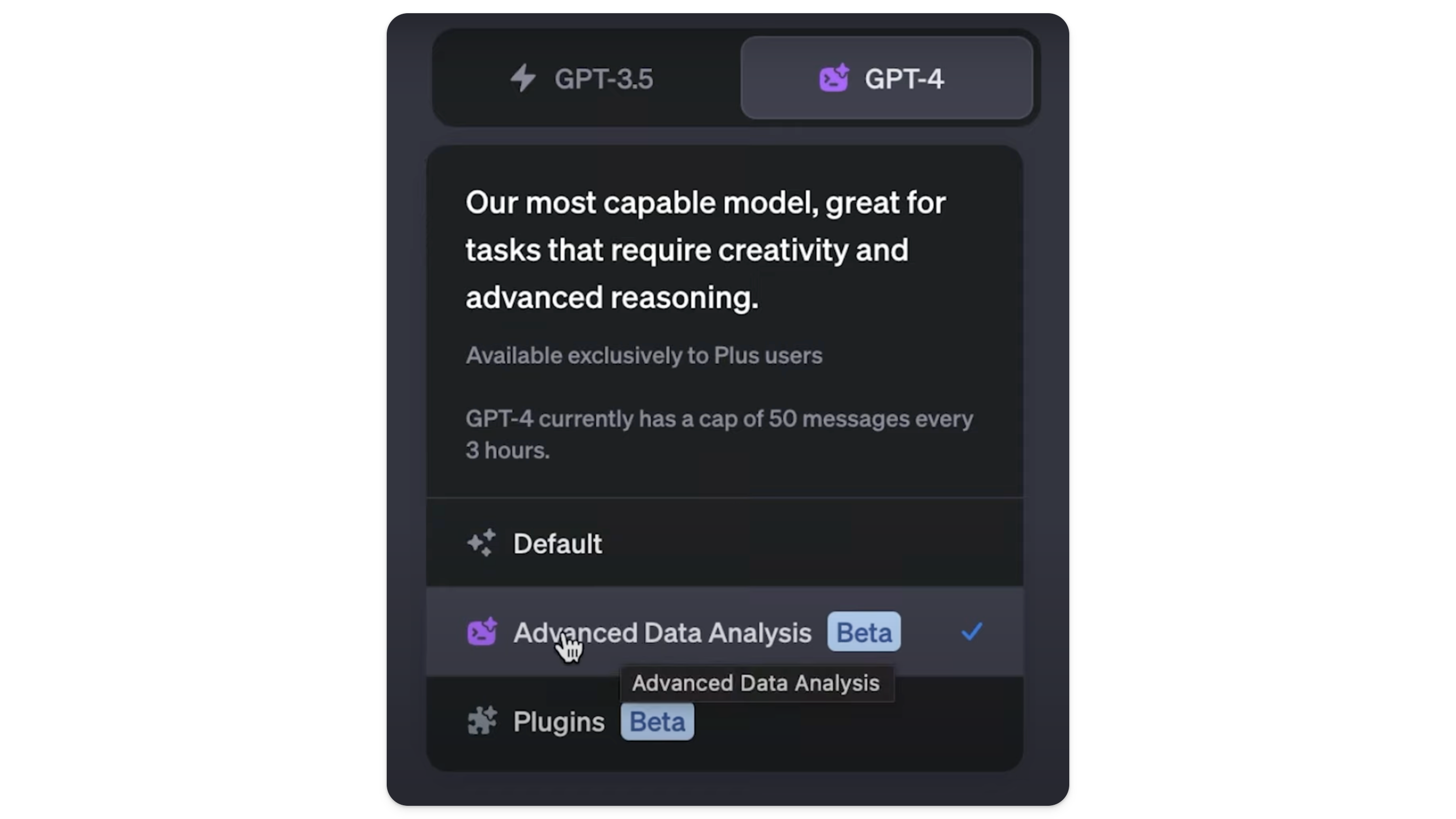
For example:
“You are an expert direct response copywriter who can write high converting and high click-through rate ads for Google Ads.
You are writing ad copy for a campaign targeted at people looking for a company described as follows:
[ENTER RESPONSE FROM STEP 1]
Write a list of headlines based on this information for this company for their Google Ads campaign.
The campaign is focused on promoting:
[ENTER PRIMARY FOCUS OF CAMPAIGN]
Headlines must be no less than 24 characters and no more than 30 characters and should be primarily focused on the service/offer mentioned above.
Make sure all copy is clear, direct, and compelling, punchy, benefit-driven and easy to understand. Write headlines in bullet point format (no full stops or exclamation marks or other punctuation at the end of each headline). Do not include the name of the company in headlines – focus on the benefits. Don’t try to be too clever or creative. Simplicity and clarity. Wording should be at the level of a 4th grader. No fancy language. All copy should be compelling, specific and benefit focused. Remember this is for a google ads campaign so we want headlines to be varied and hitting different angles and benefits to cover all the bases that customers are looking for in a company that provides this product/service.
Check if any headlines are not in the specified range of 24 to 30 characters using the LEN function. If any are not then fix this before you proceed. Ask for my approval and then proceed with the next step. If headlines are all in the correct character length range and I have approved then create 10 descriptions of the benefit laid out in the headline expanded to be as clear and compelling as possible. Must be no less than 75 characters and no more than 90 characters. Check again with LEN function to confirm and adjust if necessary.
Again make sure all copy is clear, direct, and compelling, punchy, benefit-driven and easy to understand. Don’t try to be too clever or creative. Simplicity and clarity. Wording should be at the level of a 4th grader. No fancy language. All copy should be compelling, specific and benefit focused. Ask me to confirm I like the descriptions and then proceed with the last review where you will again check using the LEN function if the headlines and descriptions are within the character count requirements. You will also check that they are relevant to someone looking for the service that the campaign is focused on.”
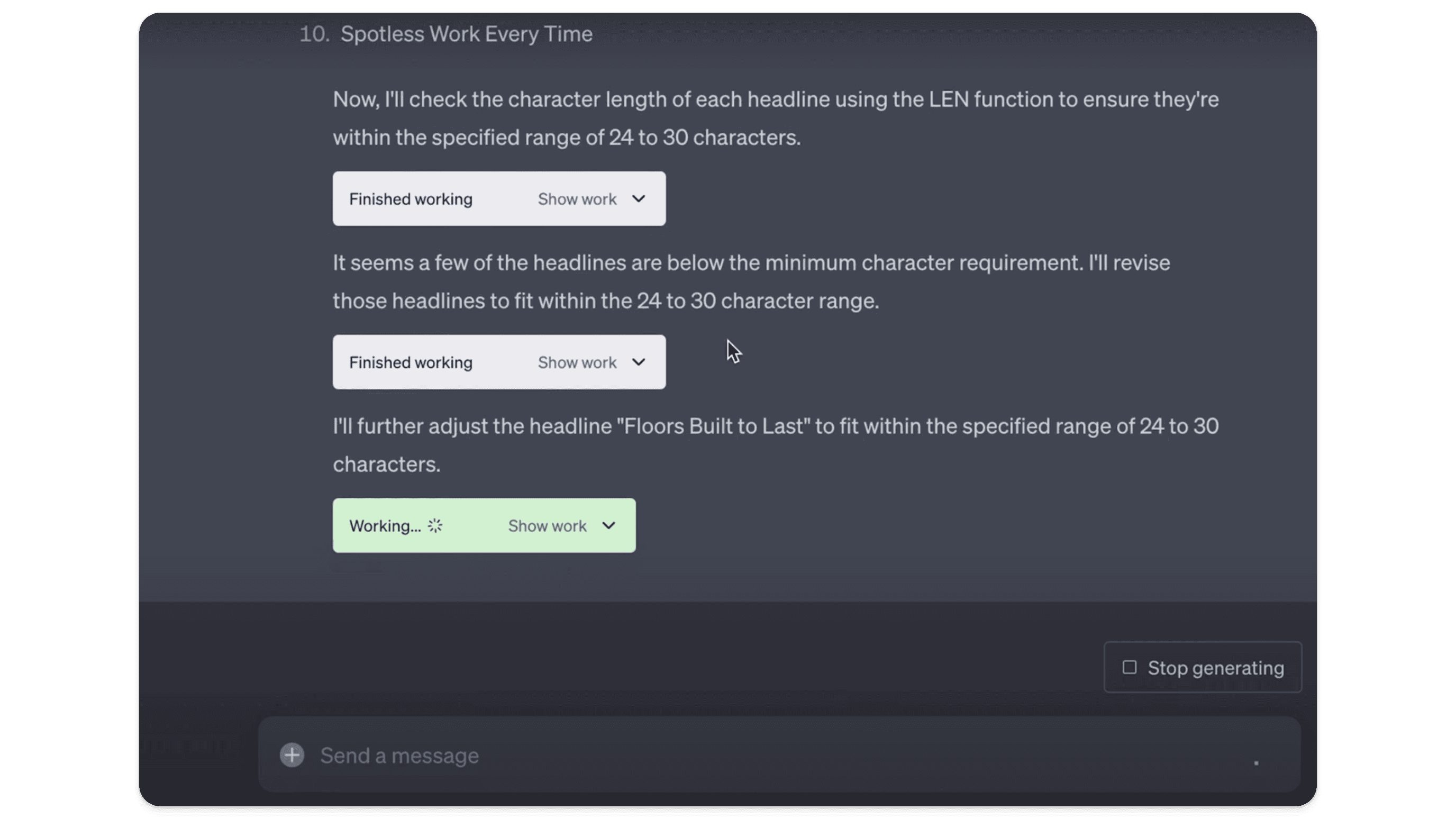
This method will provide more targeted and relevant ad copy tailored to your business or industry, helping your responsive search ads stand out in a crowded marketplace.
Pros:
Provides highly relevant and specific ad copy.
Targets the exact needs and desires of your audience.
Cons:
Requires additional setup time for website analysis.
May need further refinement (and ad copy testing) to perfect the copy.
The results? See for yourself:
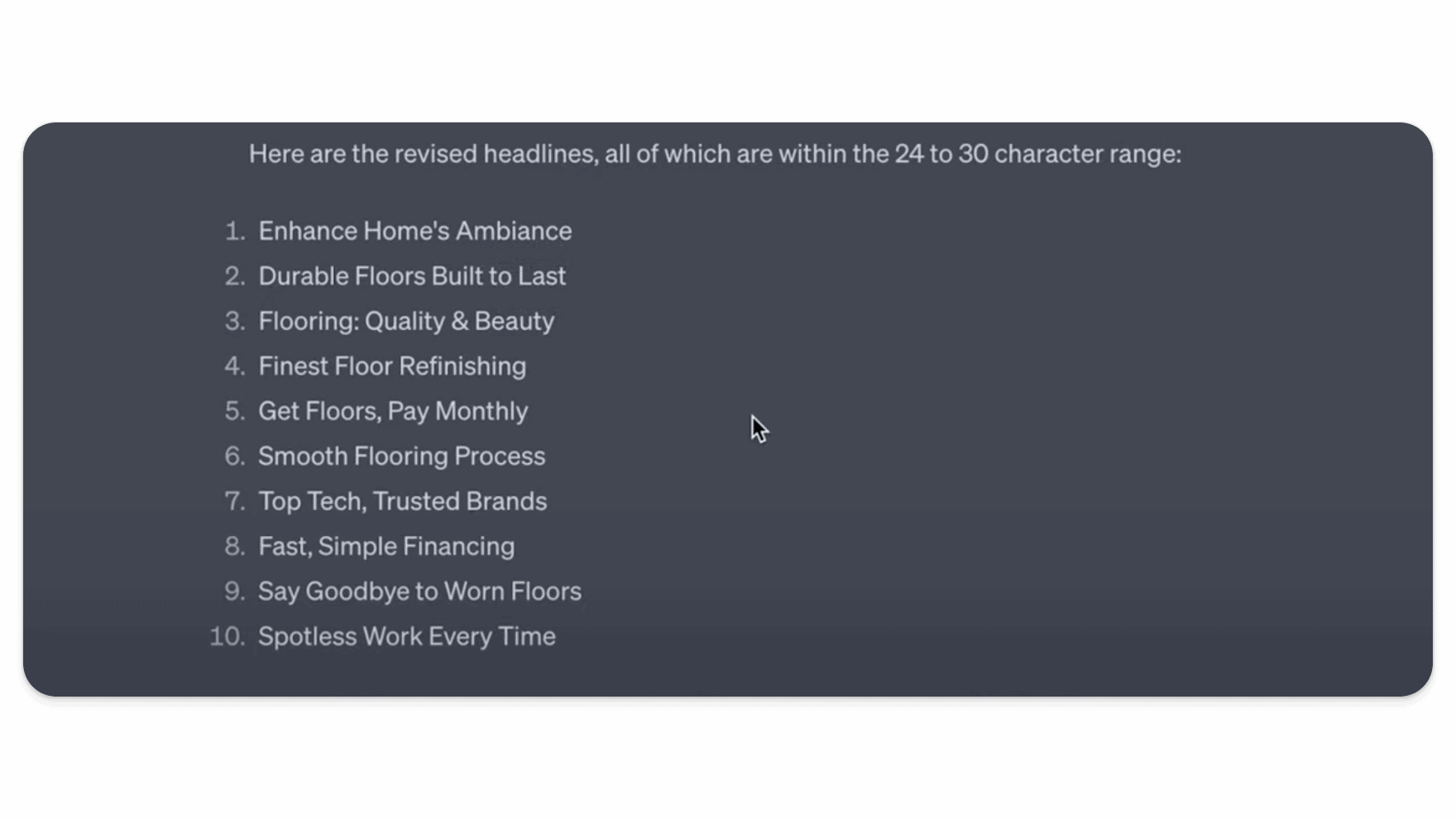
Provided you like the headlines ChatGPT has come up with, you can have it proceed to write compelling descriptions. Again, you’ll only be using 2 or 3 headlines and descriptions to test within your responsive search ad.
Method 3: Benefit Extraction
Use Bing’s Chat Feature for Website Analysis: This is the same process we used in Method 2. Your prompt can read as follows:
“Browse this website: [WEBSITE URL]
Provide the following to assist with creating marketing materials for this company:
Main list of services
Target market
Unique selling propositions
Advantages of working with this company over competitors
Main motivations of potential customers needing this service (why they need it)
Primary features of the main services
Major corresponding benefits of these services
Any other key information about this business”
Defining Customer Motivations (ChatGPT 4 Advanced Data Analysis): Use ChatGPT 4 to summarize and extract the motivations of the market, as we can then create responsive search ads around what people are actually looking for. This is the prompt we recommend using to generate effective Google ads:
“You are a world-class marketing audience research expert with a doctorate in behavioral psychology and a masters in human emotion. Today I’m going to ask you to apply those skills to analyze the psyche of the client avatar targeted by this company:
[ENTER RESPONSE FROM STEP 1]
Give me a bulleted list of the motivations of a prospective customer of this company when it comes to working with a company in the industry of the company linked.
Also include a list of hesitations they may have around working with such a company, and the biggest reasons they may decide to choose a particular provider over another.
List also what they are probably looking for in terms of features and benefits of a potential company.
Include psychological motivations and fears and buying triggers. Try to describe these elements more clearly and deeply than the prospective customer can articulate themselves.
We’re really trying to get into the head of a customer first, before writing the ad copy. This enables us to create the most compelling responsive search ads. Here’s ChatGPT’s response:
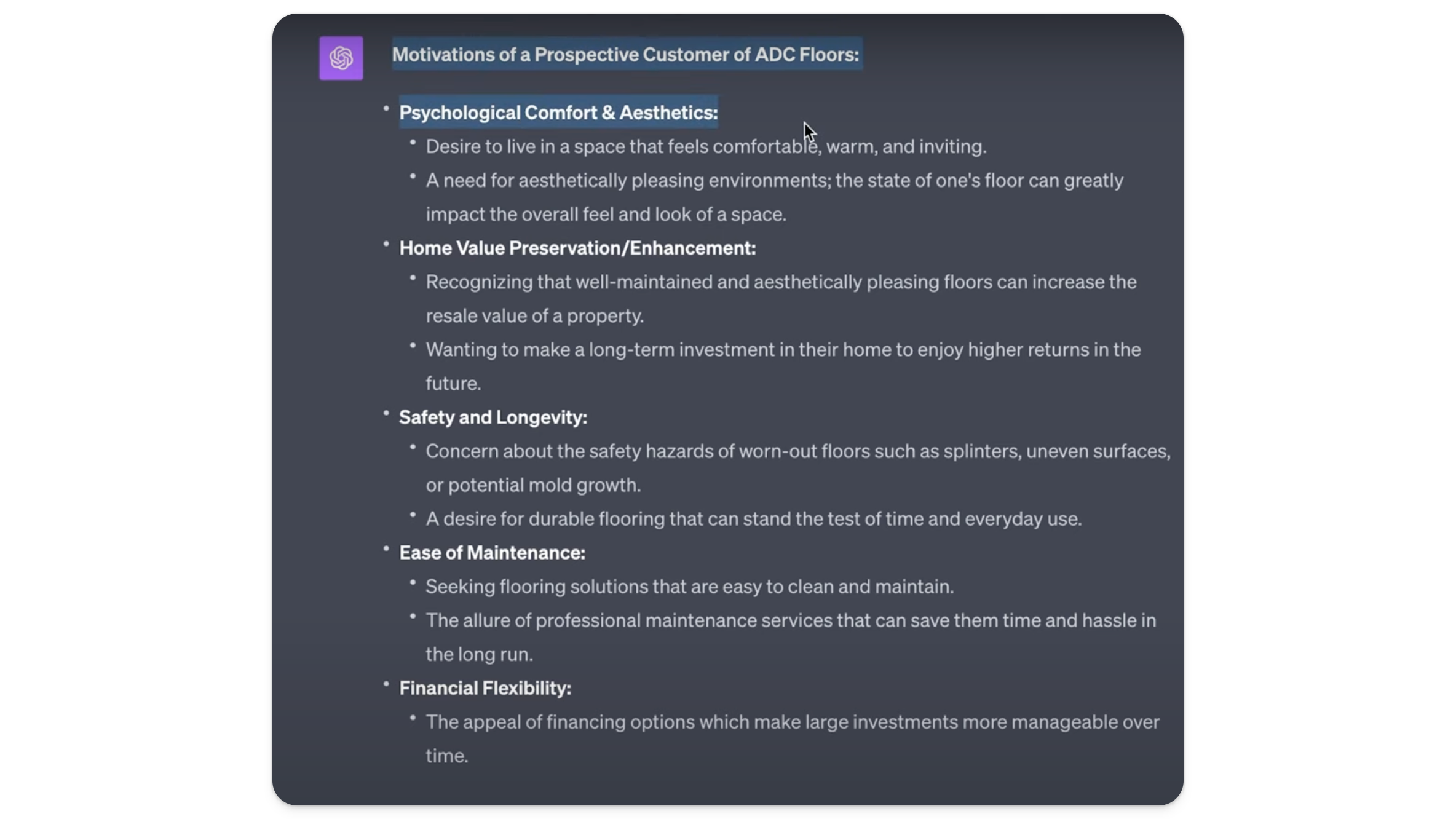
This response was extensive, and contains the building blocks of good copy.
Extract Features & Benefits
Next, respond to ChatGPT with the below:
“Based on the response you gave above, come up with the top 10-20 best potential features and top 10-20 most compelling benefits for a company in this industry looking to stand out in a crowded market to customers. Try to be specific and make sure to tailor all features and benefits back to the motivations, desires and hesitations of the customer looking for this kind of service/offer.
These features and benefits have to be realistic and tangible (no magic – all practical). But they can be explanations of common aspects of the service/product that are often overlooked that strongly benefit the customer.
They must also match or closely resemble the services that are described in the company description previously or seem to be likely to be offered by this company.ChatGPT’s response might look something like this:
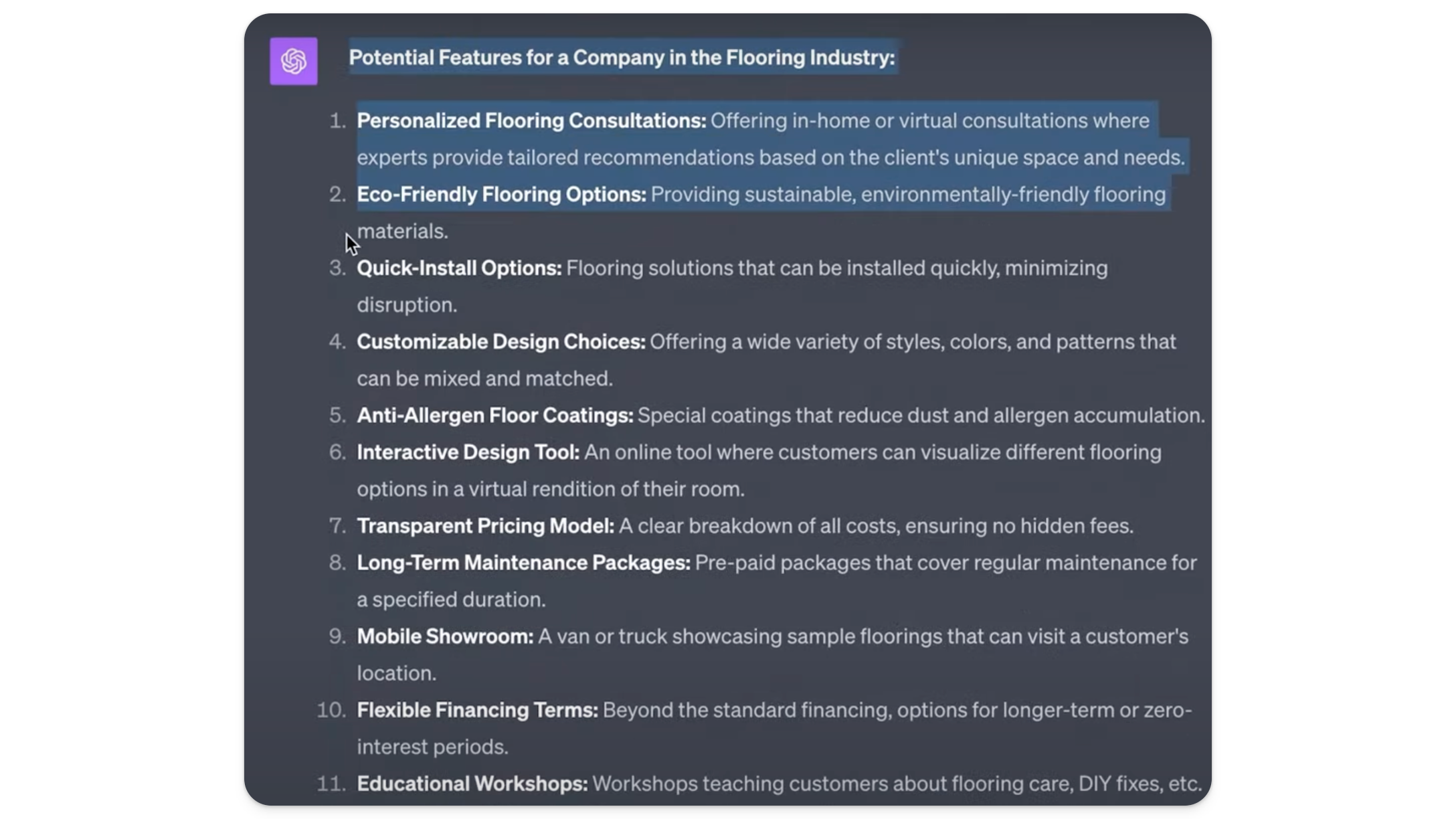
Again, it has done a great job of spitting out the company’s unique features, and how those features benefit the company’s target audience. Having a wide range of content to choose from is helpful when creating multiple responsive search ads on the Google Ads platform.
Write Google Ads Responsive Search Ads Headlines and Descriptions
Finally, ask ChatGPT to take the materials (and relevant keywords) it has created so far to write powerful, high converting responsive search ads. You might consider using this prompt:
“Here is my plan: I am creating a Google search campaign for this service in which I will run a split test. The campaign is focused on promoting the main service that was outlined in the company description.
I am going to split test 3 responsive search ads in Google Ads. A responsive search ad is made up of 5 headlines and 2-3 descriptions
First I want you to decide the themes of each ad that will be split tested and ask if I approve. The themes should be different enough to properly test and determine a winner. Make sure the themes relate to the name of the offer/service in question.Headlines in both themes must still be relevant to the service I am promoting and contain the main keyword. The headlines must be relevant to someone searching for the service being offered by this company (and should contain the core words that describe this service). However they will have different themes/angles so we can determine which angle customers are more interested in when we split test.
Once I’ve approved then write a list of headlines based on this information for this company for their Google Ads campaign that fit into each theme/angle. 5 headlines in each angle/theme. Headlines must be no less than 24 characters long and no more than 30 characters and should be primarily focused on the service/offer mentioned above.Make sure all copy is clear, direct, and compelling, punchy, benefit-driven and easy to understand. Write headlines in bullet point format (no full stops or exclamation marks or other punctuation at the end of each headline). Do not include the name of the company in headlines. Focus on the benefits. Don’t try to be too clever or creative. Simplicity and clarity. Wording should be at the level of a 4th grader. No fancy language. All responsive search ad copy should be compelling, specific and benefit focused. Remember this is for a google ads campaign so we want headlines to be varied and hitting different angles and benefits to cover all the bases that customers are looking for in a company that provides this product/service.
Try to come up with headlines that are varied so that if they are tested they give different results in terms of click through rate in Google Ads. If the headlines are too similar it will be difficult to test them as they will result in very similar click through rates.
Check if any headlines are not in the specified range of 24 to 30 characters using the LEN function. If any are not then fix this before you proceed. Ask for my approval and then proceed with the next step. If headlines are all in the correct character length range and I have approved then create 2-3 descriptions for each theme. (Check again to confirm the headlines are in the correct range of character count).
These descriptions can focus on the benefit laid out in one of the headlines (expanded to be as clear and compelling as possible). They can also be related to the theme of the overall ad variant.
Descriptions must be no less than 75 characters and no more than 90 characters. Check again with the LEN function to confirm and adjust if necessary.Again make sure all copy is clear, direct, and compelling, punchy, benefit-driven and easy to understand. Don’t try to be too clever or creative. Simplicity and clarity. Wording should be at the level of a 4th grader. No fancy language. All copy should be compelling, specific and benefit focused.
Ask me to confirm I like the descriptions and then proceed with the last review where you will again check using the LEN function if the headlines and descriptions are within the character count requirements. You will also check that they are relevant to someone looking for the service that the campaign is focused on.
Before you proceed with this prompt, confirm you have read it and understand exactly what is being asked of you.
And when I’ve approved everything then give me the copy of each ad in a simple table so I can copy and paste into a google sheet. (Just the headlines and descriptions at this point – no character counts or other formatting).
Columns in table should be:Theme
Headlines
Descriptions
Essentially, the above prompt asks ChatGPT to create three search ads, each with five headlines and three descriptions that are themed differently so that you can input these ads as responsive search ads inside of your Google Ads account.
Why do all of this? Simple. Responsive search ads no longer operate as text ads used to in the past. Now, you can’t choose a specific headline and a specific description and have Google show those every single time. Therefore, it can be very difficult to test specific copy in your ads, and to move the needle on performance on ad copy.
That’s why the best practice now is the create different themes between different ads, so that Google can split test the themes.
Advanced Split Testing with Themed Ads
Split testing (also known as A/B testing) is essential for optimizing any Google Ads campaign. With RSAs, however, it’s more complex because Google dynamically selects different headlines and descriptions. To truly maximize your ad performance, you need to create ads with clear, distinct themes that Google can test against each other.
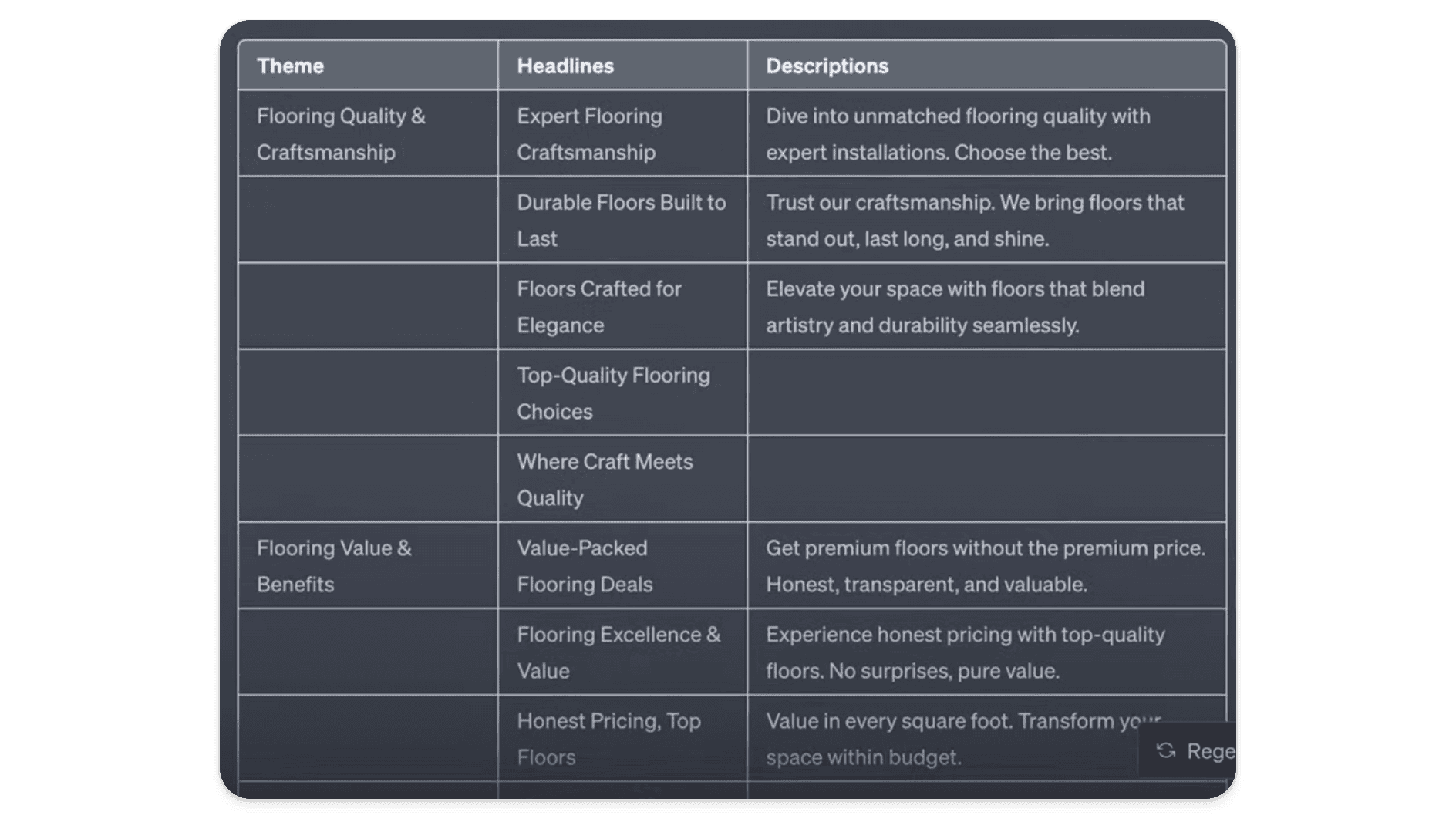
You’ll notice in the table above (created using the last ChatGPT prompt) that there are two themes:
Theme 1: Emphasizing Quality and Craftsmanship
Headline Examples:“Expert Flooring Craftsmanship”
“Durable Floors Built to Last”
Theme 2: Highlighting Affordability and Value
Headline Examples:“Affordable Flooring Solutions”
“Get Quality Floors at the Best Price”
By creating distinct themes, you can track which type of messaging resonates more with your audience. Once you have your ad variations, you can test them in Google Ads to see which theme produces the highest click-through and conversion rates for your responsive search ads.
Step 4: Iterating and Refining Your Responsive Search Ads with ChatGPT
Once your responsive search ads are live and you’ve gathered performance data, it’s time to refine your ad copy based on what’s working. Continuous refinement is crucial for long-term campaign success, as it allows you to hone in on the copy elements that drive the best results.
Track the following performance metrics:
Click-through rate (CTR): Indicates how effective your ad is at capturing attention.
Conversion rate (CVR): Measures how well your ad turns clicks into conversions.
Cost per click (CPC): Shows the average cost for each click, helping you manage your ad budget.
After gathering data, you can return to ChatGPT and refine your copy based on the winning elements from your top-performing search ads. Here’s an example of a refinement prompt:
“Using the following best-performing ad elements [insert top-performing headlines/descriptions], generate 5 new headlines and 3 new descriptions. Ensure the new copy builds on these successful elements, is more benefit-focused, and adheres to Google’s character limits.”
This iterative process will help you continually improve your Google Ads over time.
Step 5: Extracting Customer Motivations for Highly Targeted Ads
One of the most powerful ways to use ChatGPT for writing Google Ads is to focus on customer psychology. By analyzing the motivations, fears, and hesitations of your target audience, you can craft Google Ads copy that addresses their pain points and speaks directly to their desires.
Use a prompt like this to extract deeper insights:
“You are a marketing expert specializing in customer psychology. Based on the following website summary [insert summary], list the primary motivations, concerns, and hesitations of potential customers. Use these insights to craft ad copy that addresses these elements. Include emotional triggers and psychological drivers in the ad text.”
This approach ensures your ads speak to the core needs of your customers, making your ads not only more engaging but also more likely to convert.
Final Thoughts
Incorporating AI like ChatGPT into your Google Ads strategy can revolutionize the way you create, test, and optimize your responsive search ads. From quickly generating compelling Google Ads copy to conducting advanced split tests, AI saves time and enhances performance.
By leveraging tools like ChatGPT for themed split tests, customer motivation analysis, and continuous refinement, you’ll improve your click-through and conversion rates — helping you achieve better results and a higher return on investment (ROI) for your Google Ads campaigns.
Now that you have the tools and strategies, it’s time to start integrating AI into your Google Ads. Whether you’re crafting your first responsive search ad or refining a mature campaign, AI can help you at every stage of the process.
Let us know how these strategies work for you, and happy testing!
Is your Google Ads strategy not delivering the results you want? Sometimes, a fresh perspective and a data-driven PPC approach are all it takes to turn things around. If you’re aiming for better performance, consider working with a Minneapolis PPC agency for Midwest coverage, a Salt Lake City PPC agency for Utah expertise, or a Baltimore PPC agency for East Coast reach. Tapping into local insights can help you fine-tune your campaigns, attract more qualified leads, and see real improvements in your ROI.



